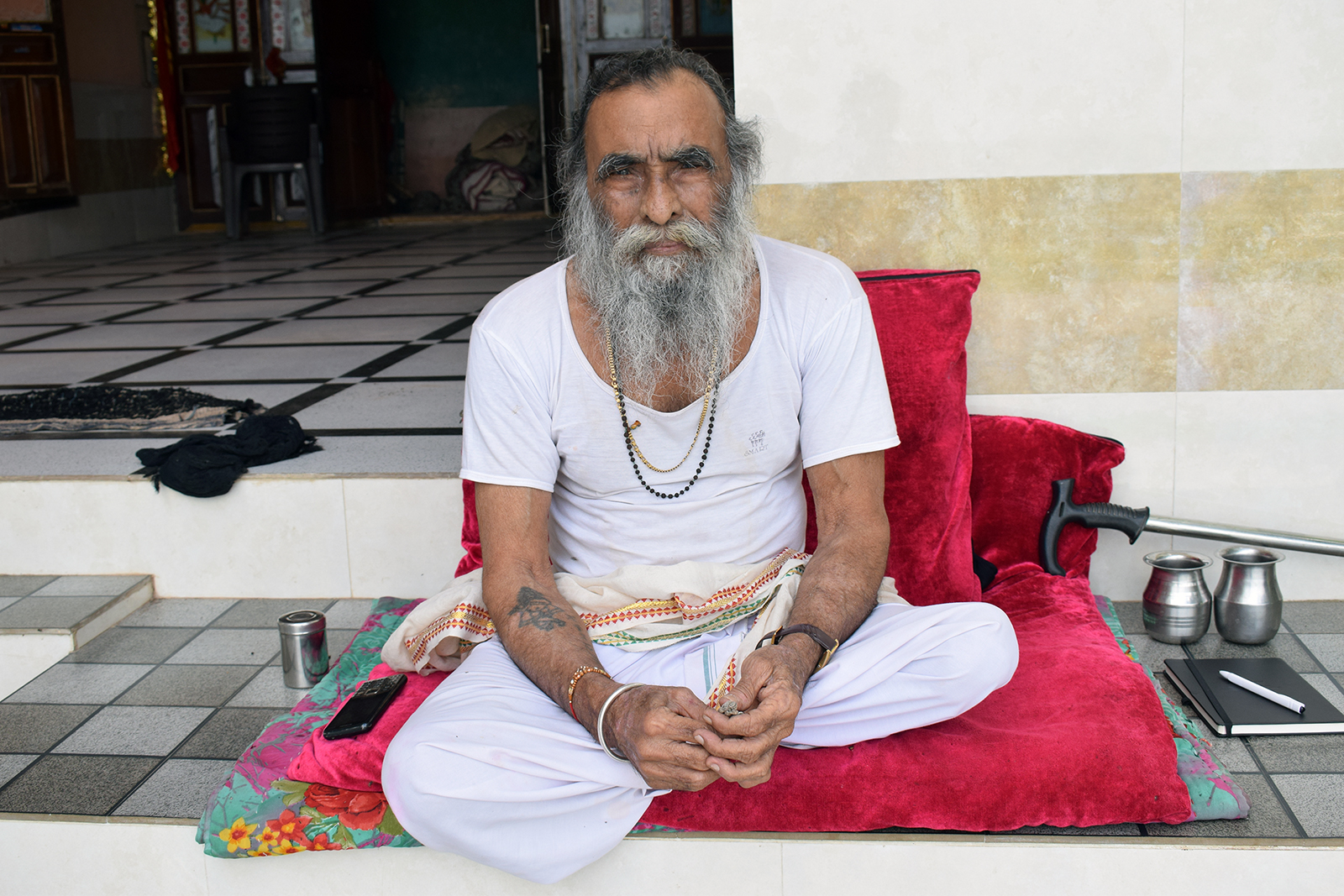GUJARAT, India (RNS) — Every morning at the Momai Mata temple, near the southern tip of the Gujarat peninsula, a Hindu priest offers prayers. The temple, carved out of rock in an ancient cave by Buddhist monks, is one in a complex of 62 caves chiseled into the rocky slopes of Gujarat’s lush Sana Hills where thousands of monks once worshipped.
But on a signboard next to the Momai Mata temple reading “Relics of a Buddhist past,” the word “Buddhist” has been erased, an indicator of simmering tensions as Hindu chauvinists have taken over the complex.
Sana, with its intricate rock-cut architecture, stupas, meditation crevices and prayer halls, is a testament to the Gir-Somnath district’s rich Buddhist past, where from first century B.C. to the first century A.D. thousands of Buddhist monks and nuns created, studied and meditated, pursuing enlightenment in these sacred chambers hewn from soft rock.
But many Hindus, including Ram Sharan Das, the 70-year-old Hindu priest who leads worship at the Momai Mata temple, assert that the caves were built by the mythical warrior Bhima, a figure who appears in the Hindu epic Mahabharata.
“It’s our belief that these caves were sculpted more than 5,000 years ago,” said Das, wearing a starched white dhoti and a string of basil beads around his neck. “All this talk of a Buddhist past is imaginary.”

Hindu priest Ram Sharan Das offers daily morning prayers at the Sana Buddhist Caves in the Gir-Somnath district of Gujarat, India. (Photo by Priyadarshini Sen)
More than six years ago, India’s tourism ministry proposed advertising the Buddhist sites of Sana and others in the region, thinking it would draw pilgrims as well as boost ecotourism. The plan included equipping key Buddhist sites in India with “state-of-the-art facilities.”
The proposal was also in keeping with efforts by Prime Minister Narendra Modi, a former chief minister of Gujarat, to make Buddhism a vital part of India’s foreign policy in recent years. Modi has frequently referred to his native state as a center of Buddhist learning. Last year at the Global Buddhist Summit in Delhi, Modi said the world’s challenges, from war to economic crises to climate change, could be addressed through Lord Buddha’s teachings.
Modi has particularly fostered ties with neo-Buddhists, followers of the prominent low-caste 20th-century reformer B.R. Ambedkar. A fierce opponent of the Hindu caste system, Ambedkar encouraged many Dalits, members of the lowest caste, to embrace Buddhism to escape caste discrimination.
Neo-Buddhists have been among the loudest voices calling for the preservation of Gujarat’s 2,000-year-old Buddhist landmarks. Sana was among the 13 sites to be developed for the Gujarat Buddhist tourism circuit, but neo-Buddhist activists charge that India’s archaeology agency hasn’t adequately protected the caves.
“The government doesn’t want to protect Buddhist sites,” said Nilesh Kathar, a Dalit writer and author of “The Buddhist Caves in Saurashtra-Kachchh,” a book about the Buddhist ruins in Gujarat’s peninsula region. “These have become strongholds of Hindu chauvinists in the lack of sufficient care.”
Ashish Baudh, an activist from the coastal town of Diu, said: “Temples dedicated to local Hindu deities have sprouted all over Sana. This is a way to erase our Buddhist past.”
In the surrounding villages, residents say, the neglect has not only enabled upper-caste Hindus to assert their dominance over the site but has also spread many myths about its history. One cave has been christened Bhimchori, linking it to mythical warrior Bhima’s wedding, with no historical evidence.

Hindu temples and other structures that have been built around the Sana Buddhist Caves in Gujarat, India. (Photo by Priyadarshini Sen)
“Politicians promise many things before the elections but they fail to sensitize people about our history,” said Bhaylu Bhai, a farmer and taxi driver from a nearby village. “Their disregard has led to the proliferation of Hindu worship rituals, devotional music programs and pilgrimages.”
The earliest archaeological evidence of Buddhism in Gujarat goes back to Emperor Ashoka’s reign in 268 B.C., and Sana’s area is mentioned in early Buddhist literature. The Chinese traveler Xuanzang noted the presence of more than 200 monasteries in Gujarat, which housed thousands of monks studying art, history, culture and philosophy.
Spurred by these findings, an activist from the town of Una filed a request in 2021 under India’s Right to Information Act demanding information from the government on Sana’s development plan. “I asked where have the millions of funds gone, why have (signs) been destroyed, and why are people promoting this as a Hindu religious site? I got no response from them,” he said.
Last September, hundreds of volunteers of the civil rights group Swayam Sainik Dal, which advocates Buddha’s teachings, marched to the Sana caves to call attention to its preservation.
“We want a humanist nation where the ideas of our spiritual masters are carried forward, not one where upper-caste Hindus dominate,” said Sanjay Rathod, an SSD volunteer.

Only two pillars remain of the Abalmandap, a cave on the foothills that was used as a space for teachings and discussions on Buddha’s Dhamma, at the Sana Buddhist Caves in the Gir-Somnath district of Gujarat, India. The caves date back to the first century B.C. (Photo by Priyadarshini Sen)
The fight for Sana’s preservation, Rathod said, isn’t just about cultural heritage, but against caste discrimination, inequality and religious superstition.
Every few months, SSD volunteers and grassroots-level activists armed with cardboard cutouts of the Buddha, flags and banners depicting the caves congregate at the ancient site to raise awareness about Buddhism.
“We’ve petitioned government officers but no one’s taken any action yet,” said Kirit Baudh, a schoolteacher from the district. “Now we’ve decided go from village to village to educate people about inclusion, compassion and generosity that Buddhism propagates.”

The state of Gujarat in western India. (Image courtesy of Wikimedia/Creative Commons)
In October 2022, some 900 people converted to Buddhism in the Gir-Somnath region following an assault in 2016 on seven members of a Dalit family. Videos of the floggings, which the assailants said were in response to mistreatment of cows, held sacred in Hinduism, went viral on social media and led to statewide protests. More than 43 people were arrested, including four Gujarat police officers.
Last April, the Gujarat government distributed circulars clarifying that Buddhism is a separate religion from Hinduism and any conversions from Hinduism to Buddhism would require the approval of the district magistrate under the provisions of the Gujarat Freedom of Religion Act, 2003.
Under these circumstances, activists say preservation of Sana’s Buddhist past becomes more critical as the focus of preservation of Buddhist culture and history in general.
Das, the Hindu priest at the Momai Mata temple, believes Sana’s preservation should be for the benefit of Hindus. The government and archaeology department, he said, are doing their best to “modernize their treasure trove.”
“Everyone knows that Hindus need to forefront their heritage,” he said. “What we want is more temples, security guards, cleanliness and modern facilities to turn Sana into a world-class tourist destination.”
Queries to India’s Ministry of Minority Affairs, as well as Gujarat’s tourism department, went unanswered.
Dinesh Makwana, a local official, said it’s time the international Buddhist community stepped in to reacquaint people with the idea that India is the land of the Buddha.
“Gujarat’s peninsula region was swept by Buddhism and people are forgetting that,” said Makwana. “The authenticity of heritage should be preserved, regardless of religion or caste.”















